Nabeel Mohammed
LegalRAG: A Hybrid RAG System for Multilingual Legal Information Retrieval
Apr 19, 2025Abstract:Natural Language Processing (NLP) and computational linguistic techniques are increasingly being applied across various domains, yet their use in legal and regulatory tasks remains limited. To address this gap, we develop an efficient bilingual question-answering framework for regulatory documents, specifically the Bangladesh Police Gazettes, which contain both English and Bangla text. Our approach employs modern Retrieval Augmented Generation (RAG) pipelines to enhance information retrieval and response generation. In addition to conventional RAG pipelines, we propose an advanced RAG-based approach that improves retrieval performance, leading to more precise answers. This system enables efficient searching for specific government legal notices, making legal information more accessible. We evaluate both our proposed and conventional RAG systems on a diverse test set on Bangladesh Police Gazettes, demonstrating that our approach consistently outperforms existing methods across all evaluation metrics.
VideoLights: Feature Refinement and Cross-Task Alignment Transformer for Joint Video Highlight Detection and Moment Retrieval
Dec 02, 2024Abstract:Video Highlight Detection and Moment Retrieval (HD/MR) are essential in video analysis. Recent joint prediction transformer models often overlook their cross-task dynamics and video-text alignment and refinement. Moreover, most models typically use limited, uni-directional attention mechanisms, resulting in weakly integrated representations and suboptimal performance in capturing the interdependence between video and text modalities. Although large-language and vision-language models (LLM/LVLMs) have gained prominence across various domains, their application in this field remains relatively underexplored. Here we propose VideoLights, a novel HD/MR framework addressing these limitations through (i) Convolutional Projection and Feature Refinement modules with an alignment loss for better video-text feature alignment, (ii) Bi-Directional Cross-Modal Fusion network for strongly coupled query-aware clip representations, and (iii) Uni-directional joint-task feedback mechanism enhancing both tasks through correlation. In addition, (iv) we introduce hard positive/negative losses for adaptive error penalization and improved learning, and (v) leverage LVLMs like BLIP-2 for enhanced multimodal feature integration and intelligent pretraining using synthetic data generated from LVLMs. Comprehensive experiments on QVHighlights, TVSum, and Charades-STA benchmarks demonstrate state-of-the-art performance. Codes and models are available at https://github.com/dpaul06/VideoLights .
Empowering Meta-Analysis: Leveraging Large Language Models for Scientific Synthesis
Nov 16, 2024Abstract:This study investigates the automation of meta-analysis in scientific documents using large language models (LLMs). Meta-analysis is a robust statistical method that synthesizes the findings of multiple studies support articles to provide a comprehensive understanding. We know that a meta-article provides a structured analysis of several articles. However, conducting meta-analysis by hand is labor-intensive, time-consuming, and susceptible to human error, highlighting the need for automated pipelines to streamline the process. Our research introduces a novel approach that fine-tunes the LLM on extensive scientific datasets to address challenges in big data handling and structured data extraction. We automate and optimize the meta-analysis process by integrating Retrieval Augmented Generation (RAG). Tailored through prompt engineering and a new loss metric, Inverse Cosine Distance (ICD), designed for fine-tuning on large contextual datasets, LLMs efficiently generate structured meta-analysis content. Human evaluation then assesses relevance and provides information on model performance in key metrics. This research demonstrates that fine-tuned models outperform non-fine-tuned models, with fine-tuned LLMs generating 87.6% relevant meta-analysis abstracts. The relevance of the context, based on human evaluation, shows a reduction in irrelevancy from 4.56% to 1.9%. These experiments were conducted in a low-resource environment, highlighting the study's contribution to enhancing the efficiency and reliability of meta-analysis automation.
BanglaDialecto: An End-to-End AI-Powered Regional Speech Standardization
Nov 16, 2024



Abstract:This study focuses on recognizing Bangladeshi dialects and converting diverse Bengali accents into standardized formal Bengali speech. Dialects, often referred to as regional languages, are distinctive variations of a language spoken in a particular location and are identified by their phonetics, pronunciations, and lexicon. Subtle changes in pronunciation and intonation are also influenced by geographic location, educational attainment, and socioeconomic status. Dialect standardization is needed to ensure effective communication, educational consistency, access to technology, economic opportunities, and the preservation of linguistic resources while respecting cultural diversity. Being the fifth most spoken language with around 55 distinct dialects spoken by 160 million people, addressing Bangla dialects is crucial for developing inclusive communication tools. However, limited research exists due to a lack of comprehensive datasets and the challenges of handling diverse dialects. With the advancement in multilingual Large Language Models (mLLMs), emerging possibilities have been created to address the challenges of dialectal Automated Speech Recognition (ASR) and Machine Translation (MT). This study presents an end-to-end pipeline for converting dialectal Noakhali speech to standard Bangla speech. This investigation includes constructing a large-scale diverse dataset with dialectal speech signals that tailored the fine-tuning process in ASR and LLM for transcribing the dialect speech to dialect text and translating the dialect text to standard Bangla text. Our experiments demonstrated that fine-tuning the Whisper ASR model achieved a CER of 0.8% and WER of 1.5%, while the BanglaT5 model attained a BLEU score of 41.6% for dialect-to-standard text translation.
3D Point Cloud Network Pruning: When Some Weights Do not Matter
Aug 26, 2024Abstract:A point cloud is a crucial geometric data structure utilized in numerous applications. The adoption of deep neural networks referred to as Point Cloud Neural Networks (PC- NNs), for processing 3D point clouds, has significantly advanced fields that rely on 3D geometric data to enhance the efficiency of tasks. Expanding the size of both neural network models and 3D point clouds introduces significant challenges in minimizing computational and memory requirements. This is essential for meeting the demanding requirements of real-world applications, which prioritize minimal energy consumption and low latency. Therefore, investigating redundancy in PCNNs is crucial yet challenging due to their sensitivity to parameters. Additionally, traditional pruning methods face difficulties as these networks rely heavily on weights and points. Nonetheless, our research reveals a promising phenomenon that could refine standard PCNN pruning techniques. Our findings suggest that preserving only the top p% of the highest magnitude weights is crucial for accuracy preservation. For example, pruning 99% of the weights from the PointNet model still results in accuracy close to the base level. Specifically, in the ModelNet40 dataset, where the base accuracy with the PointNet model was 87. 5%, preserving only 1% of the weights still achieves an accuracy of 86.8%. Codes are available in: https://github.com/apurba-nsu-rnd-lab/PCNN_Pruning
Beyond Labels: Aligning Large Language Models with Human-like Reasoning
Aug 20, 2024



Abstract:Aligning large language models (LLMs) with a human reasoning approach ensures that LLMs produce morally correct and human-like decisions. Ethical concerns are raised because current models are prone to generating false positives and providing malicious responses. To contribute to this issue, we have curated an ethics dataset named Dataset for Aligning Reasons (DFAR), designed to aid in aligning language models to generate human-like reasons. The dataset comprises statements with ethical-unethical labels and their corresponding reasons. In this study, we employed a unique and novel fine-tuning approach that utilizes ethics labels and their corresponding reasons (L+R), in contrast to the existing fine-tuning approach that only uses labels (L). The original pre-trained versions, the existing fine-tuned versions, and our proposed fine-tuned versions of LLMs were then evaluated on an ethical-unethical classification task and a reason-generation task. Our proposed fine-tuning strategy notably outperforms the others in both tasks, achieving significantly higher accuracy scores in the classification task and lower misalignment rates in the reason-generation task. The increase in classification accuracies and decrease in misalignment rates indicate that the L+R fine-tuned models align more with human ethics. Hence, this study illustrates that injecting reasons has substantially improved the alignment of LLMs, resulting in more human-like responses. We have made the DFAR dataset and corresponding codes publicly available at https://github.com/apurba-nsu-rnd-lab/DFAR.
Shadow: A Novel Loss Function for Efficient Training in Siamese Networks
Nov 23, 2023Abstract:Despite significant recent advances in similarity detection tasks, existing approaches pose substantial challenges under memory constraints. One of the primary reasons for this is the use of computationally expensive metric learning loss functions such as Triplet Loss in Siamese networks. In this paper, we present a novel loss function called Shadow Loss that compresses the dimensions of an embedding space during loss calculation without loss of performance. The distance between the projections of the embeddings is learned from inputs on a compact projection space where distances directly correspond to a measure of class similarity. Projecting on a lower-dimension projection space, our loss function converges faster, and the resulting classified image clusters have higher inter-class and smaller intra-class distances. Shadow Loss not only reduces embedding dimensions favoring memory constraint devices but also consistently performs better than the state-of-the-art Triplet Margin Loss by an accuracy of 5\%-10\% across diverse datasets. The proposed loss function is also model agnostic, upholding its performance across several tested models. Its effectiveness and robustness across balanced, imbalanced, medical, and non-medical image datasets suggests that it is not specific to a particular model or dataset but demonstrates superior performance consistently while using less memory and computation.
BanLemma: A Word Formation Dependent Rule and Dictionary Based Bangla Lemmatizer
Nov 06, 2023
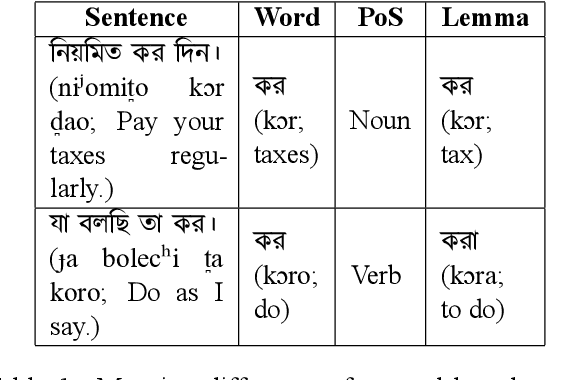


Abstract:Lemmatization holds significance in both natural language processing (NLP) and linguistics, as it effectively decreases data density and aids in comprehending contextual meaning. However, due to the highly inflected nature and morphological richness, lemmatization in Bangla text poses a complex challenge. In this study, we propose linguistic rules for lemmatization and utilize a dictionary along with the rules to design a lemmatizer specifically for Bangla. Our system aims to lemmatize words based on their parts of speech class within a given sentence. Unlike previous rule-based approaches, we analyzed the suffix marker occurrence according to the morpho-syntactic values and then utilized sequences of suffix markers instead of entire suffixes. To develop our rules, we analyze a large corpus of Bangla text from various domains, sources, and time periods to observe the word formation of inflected words. The lemmatizer achieves an accuracy of 96.36% when tested against a manually annotated test dataset by trained linguists and demonstrates competitive performance on three previously published Bangla lemmatization datasets. We are making the code and datasets publicly available at https://github.com/eblict-gigatech/BanLemma in order to contribute to the further advancement of Bangla NLP.
ChatGPT-guided Semantics for Zero-shot Learning
Oct 18, 2023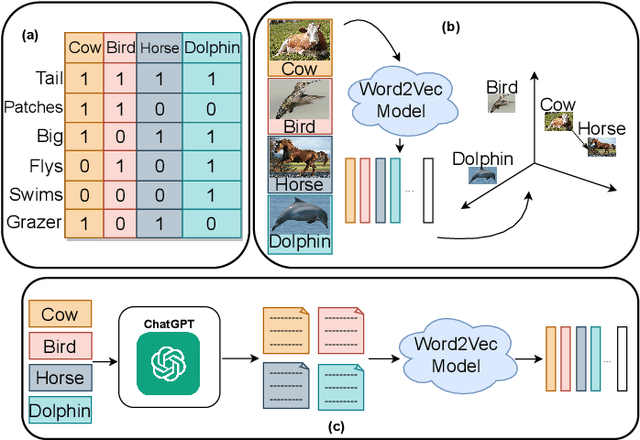
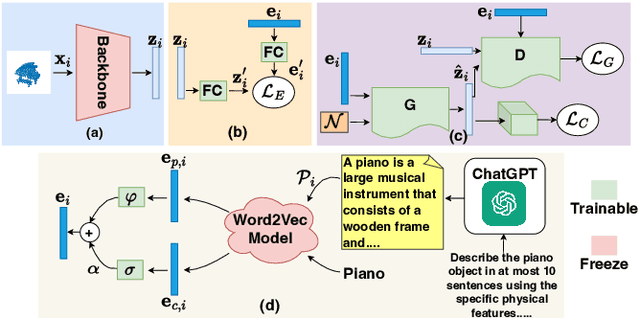

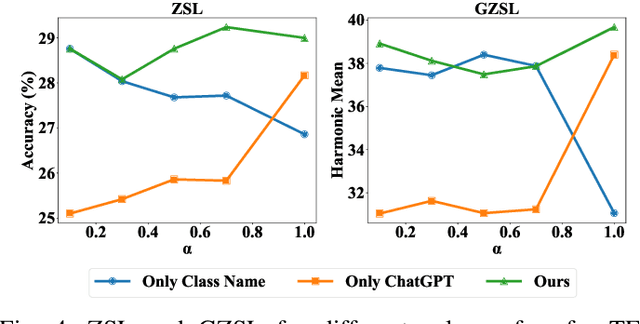
Abstract:Zero-shot learning (ZSL) aims to classify objects that are not observed or seen during training. It relies on class semantic description to transfer knowledge from the seen classes to the unseen classes. Existing methods of obtaining class semantics include manual attributes or automatic word vectors from language models (like word2vec). We know attribute annotation is costly, whereas automatic word-vectors are relatively noisy. To address this problem, we explore how ChatGPT, a large language model, can enhance class semantics for ZSL tasks. ChatGPT can be a helpful source to obtain text descriptions for each class containing related attributes and semantics. We use the word2vec model to get a word vector using the texts from ChatGPT. Then, we enrich word vectors by combining the word embeddings from class names and descriptions generated by ChatGPT. More specifically, we leverage ChatGPT to provide extra supervision for the class description, eventually benefiting ZSL models. We evaluate our approach on various 2D image (CUB and AwA) and 3D point cloud (ModelNet10, ModelNet40, and ScanObjectNN) datasets and show that it improves ZSL performance. Our work contributes to the ZSL literature by applying ChatGPT for class semantics enhancement and proposing a novel word vector fusion method.
LumiNet: The Bright Side of Perceptual Knowledge Distillation
Oct 05, 2023
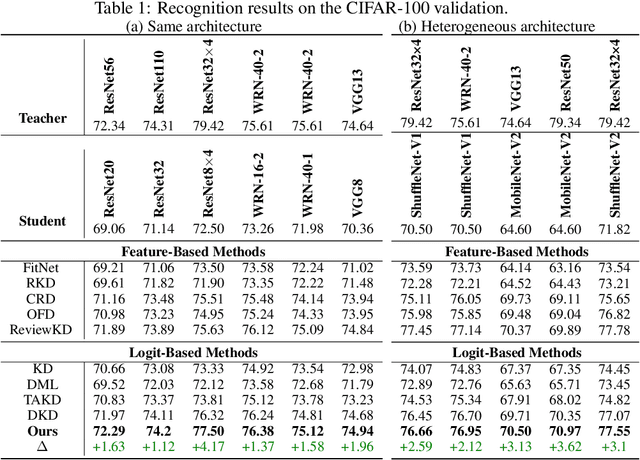

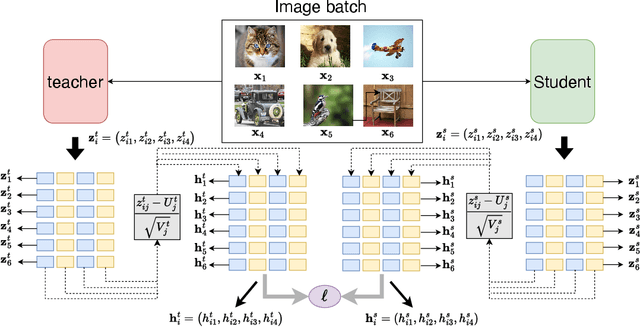
Abstract:In knowledge distillation research, feature-based methods have dominated due to their ability to effectively tap into extensive teacher models. In contrast, logit-based approaches are considered to be less adept at extracting hidden 'dark knowledge' from teachers. To bridge this gap, we present LumiNet, a novel knowledge-transfer algorithm designed to enhance logit-based distillation. We introduce a perception matrix that aims to recalibrate logits through adjustments based on the model's representation capability. By meticulously analyzing intra-class dynamics, LumiNet reconstructs more granular inter-class relationships, enabling the student model to learn a richer breadth of knowledge. Both teacher and student models are mapped onto this refined matrix, with the student's goal being to minimize representational discrepancies. Rigorous testing on benchmark datasets (CIFAR-100, ImageNet, and MSCOCO) attests to LumiNet's efficacy, revealing its competitive edge over leading feature-based methods. Moreover, in exploring the realm of transfer learning, we assess how effectively the student model, trained using our method, adapts to downstream tasks. Notably, when applied to Tiny ImageNet, the transferred features exhibit remarkable performance, further underscoring LumiNet's versatility and robustness in diverse settings. With LumiNet, we hope to steer the research discourse towards a renewed interest in the latent capabilities of logit-based knowledge distillation.
 Add to Chrome
Add to Chrome Add to Firefox
Add to Firefox Add to Edge
Add to Edge